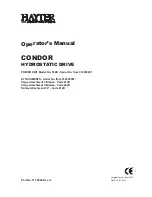
Taifun power source
Operation manual
at the evaporator coil! Here is an example:
Unominal shall be set to 4 volt
Rparasitic = (Rpos.c R R Rneg.contact)
Itotal = Unominal / (Rpa Rcoil)
Itotal = 4V / (0.025Ω + 0.025Ω + 0.025Ω + 0.025Ω + 0.7Ω) = 5A
Uparasitic = Itotal * Rparasitic = 5A * 0.1Ω = 0.5V
The current which flows through ALL resistors (Rparasitic and Rcoil) causes a useless voltage drop of 0.5 volts!
The evaporator only has 3.5 volt!
Total power Poutput = 4V * 5A = 20W
Heating power Peffective = Itotal² * Rcoil = (5A)² * 0.7Ω = 17.5W
→ 87.5% degree of efficiency on the evaporator side!
The loss is 12.5 %!
And that's just the loss on the evaporator side. You need to add the loss of efficiency on the primary side (Li-bat-
tery see point 1) and of course the loss of the control electronics.
You see that you need a relatively high current to provide the desired power (24 watts) to the very low load res-
istor of (0.7 – 6.0 ohm). At the same time the high current causes a voltage drop at the intended resistor (evapor-
ator coil) and all unintended resistors (contacts and material), which leads to a loss of power.
Simply said: You loose power at
•
the evaporator's screws
•
different contacts
•
all metal components and conductors
Conclusion: Due to the low primary voltage of the battery with simultaneous high load, the elimination of unne-
cessary parasitic resistances is essential!
3.) Resistance Measurement
Since the ohmic resistance of the evaporator coil is usually in the range of 0.7 - 3.0 ohms, it is more difficult to
measure these low resistance accurately. Again, smallest contact resistances have more of an impact.
To stay with our example of 0.1 ohm contact resistance, the measurement already has an error of about 14%. In
addition, the rounding error of the display and the internal measuring error. A display of 0.7 ohm could mean a
measured resistance of 0.65 – 0.74 ohms. And without the contact resistance 0.55 – 0.64 ohms for the coil!
All this must be taken into account if one
claims
to measure a coil resistance of, for example, 1.1 ohm.
Even if you measure a low resistance with an external milliohmmeter in the $1500 price range, it is advised to
check the measurement several times. Although these devices have a zero-point correction, a 4-wire measure-
ment (absolute requirement) and thermoelectric effect compensation (thermo EMF), the contact between the
probe prod and the test item is a challenge in itself!
If someone does a comparison measurement with a normal multimeter, the result is not really comparable (mind
you with the smallest resistance)! Take a look at the data sheets of the manufacturers of measuring instruments.
A renowned manufacturer indicates already a correction value of 0.2 ohms for the test leads (2-wire measure-
ment).
When in doubt it is better to measure the resistance by the voltage and current while the evaporator is mounted
on the power supply. Under the condition that the power supply is sufficiently accurate.
© 2013 SmokerStore GmbH
Page
: 13 of 16
Summary of Contents for the eye
Page 1: ......


































